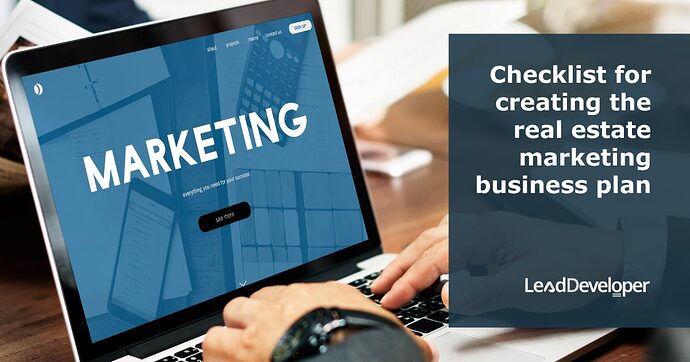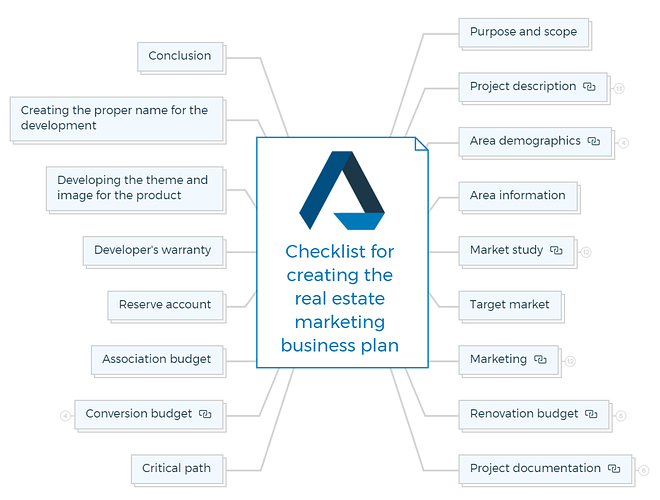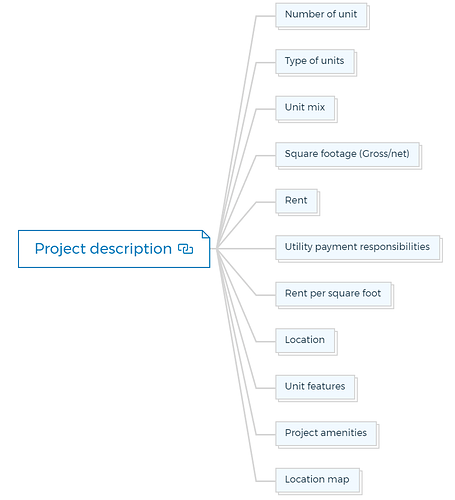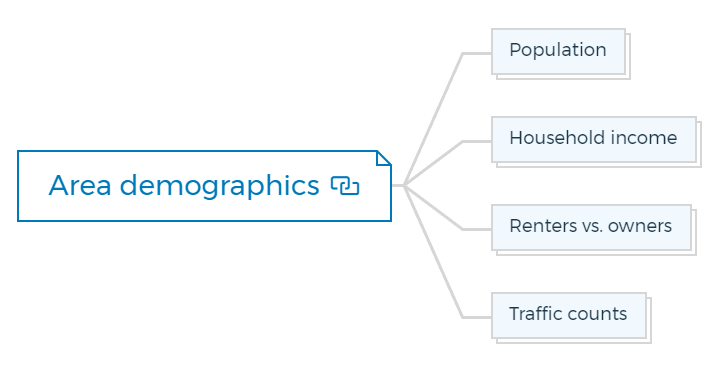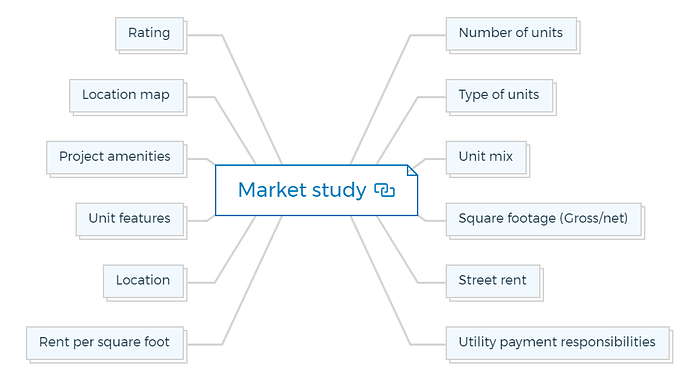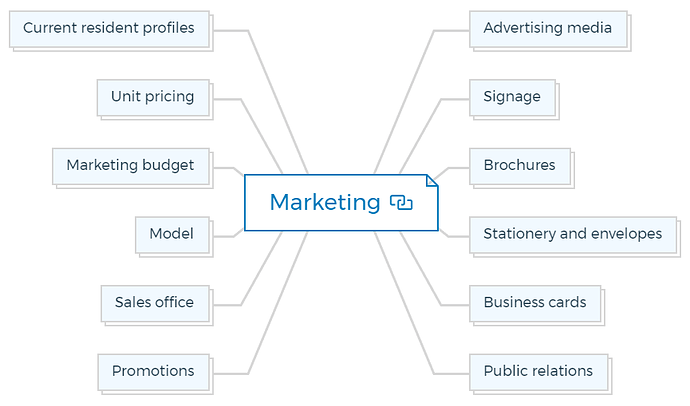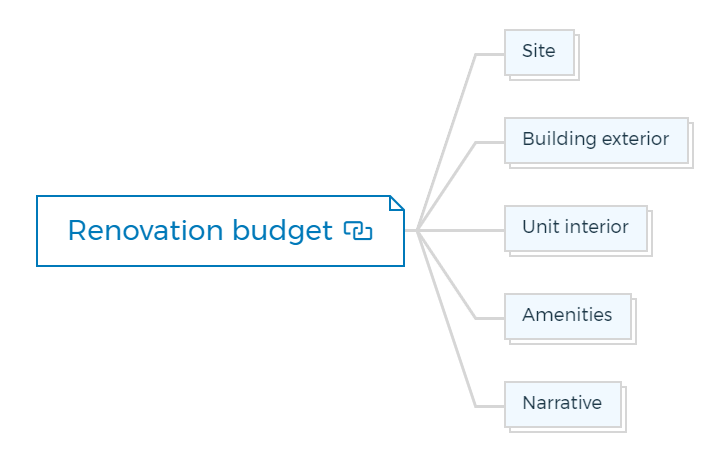Checklist for creating the real estate marketing business plan
1. Purpose and scope
- Clearly define the main purpose of the business plan: e.g., securing financing, attracting investors, guiding marketing efforts, etc.
- Specify the scope of the plan, outlining the property type, location, and target market.
2. Project description
- Provide an overview of the project’s key details, such as number and types of units, square footage, rent structure, and utility responsibilities.
- Describe the property’s unique features, amenities, and location advantages.
Number of unit
Clearly state the total number of units in the development, whether they are residential, commercial, or a mix of both.
Type of units
Specify the types of units being offered, such as apartments, townhouses, penthouses, retail spaces, etc.
Unit mix
Provide a breakdown of the unit mix, including the proportion of each type of unit (e.g., 30% one-bedroom, 50% two-bedroom, 20% three-bedroom).
Square footage (Gross/net)
Detail the gross and net square footage of each unit type, distinguishing between the total area and the livable area.
Rent
Indicate the initial or projected rental rates for each unit type, along with any variations based on floor level or other factors.
Utility payment responsibilities
Specify whether tenants are responsible for utilities like water, electricity, gas, and internet, or if these are included in the rent.
Rent per square foot
Calculate and display the average rent cost per square foot for different unit types to assist in comparisons.
Location
Describe the property’s location, highlighting its proximity to important amenities like schools, public transport, shopping centers, and parks.
Unit features
List the features and finishes that come with each unit, such as hardwood floors, granite countertops, stainless steel appliances, etc.
Project amenities
Detail the shared amenities available to residents or tenants, including gyms, pools, rooftop gardens, community spaces, and more.
Location map
Include a map that highlights the property’s location in relation to key landmarks, highways, public transportation routes, and nearby attractions.
You are missing out if you haven’t yet subscribed to our YouTube channel.
3. Area demographics
Research and present population statistics, household income ranges, renter vs. owner ratios, and traffic counts for the project’s location.
Population
Present the total population of the area and provide historical growth data if available. Include information on population density and any relevant trends.
Household income
Provide a breakdown of household income ranges in the area, including median income. This helps gauge the economic status of potential residents.
Renters vs. owners
Analyze the ratio of renters to homeowners in the vicinity. This data is crucial for understanding the local housing market dynamics.
Traffic counts
Include data on average daily traffic counts around the property. This can impact accessibility, visibility, and convenience for potential residents.
4. Area information
Discuss local employment opportunities, nearby schools, utility availability, shopping centers, transportation options, growth patterns, and historical building permits.
5. Market study
Perform a thorough comparative analysis of unit types, rental rates, amenities, and location to assess the project’s competitiveness. Study market demand and supply trends, conduct a competitive analysis, and rank competing properties. Conclude with insights into potential pricing strategies based on your analysis.
Number of units
Compare the number of units in your development with similar properties in the market to assess scale and competition.
Type of units
Analyze how the unit types you offer compare to those in competing developments. Identify unique selling points.
Unit mix
Evaluate your unit mix against market demand and determine if it aligns with preferences of potential buyers or renters.
Square footage (Gross/net)
Compare your unit sizes to similar offerings to determine if they are competitive and in line with market expectations.
Street rent
Research the average rent rates for similar properties in the area to ensure your pricing is competitive and attractive.
Utility payment responsibilities
Understand how utility responsibilities in your property compare to competitors, as this can influence tenant decisions.
Rent per square foot
Calculate and compare the average rent per square foot of your units to similar offerings to gauge affordability.
Location
Analyze your property’s location advantages and how they stack up against competing properties in terms of convenience and accessibility.
Unit features
Compare the features and finishes of your units with those of similar properties to ensure you’re meeting market expectations.
Project amenities
Assess the quality and range of amenities you offer compared to competing properties to identify competitive advantages.
Location map
Use your location map to highlight how your property’s position relative to important landmarks and infrastructure compares to others.
Rating
If possible, provide a rating or ranking for your property based on various factors such as location, amenities, unit features, and more. This helps potential buyers or renters quickly understand your property’s standing in the market.
6. Target market
Define your ideal customer base, including demographic details such as age, income, lifestyle, and preferences.
7. Marketing
Advertising media
- Newspaper: Plan advertisements in local newspapers to reach a broad audience in your target market.
- Magazines: Consider placing ads in relevant magazines catering to your demographic.
- Radio: Use radio spots to effectively communicate key property features and benefits.
- Television: Explore television advertisements to create visual impact and engage potential buyers or renters.
- Billboards: Strategically position billboards in high-traffic areas for maximum visibility.
- Direct mail: Send out postcards or brochures directly to potential buyers or renters in the local area.
- Fliers: Distribute fliers at local events or public spaces to create awareness.
Signage
- Entrance: Install an attractive and informative entrance sign to capture the attention of passersby.
- Office: Display signs in your sales office that provide project information and contact details.
- Model: Place signs outside the model unit to direct visitors and showcase unit features.
- Directional: Use directional signs within the property to guide visitors to important areas.
Brochures
- Site plan: Create brochures that display the layout of the property, including units, amenities, and common spaces.
- Floor plans: Provide detailed floor plans for each unit type to help potential buyers or renters visualize the space.
- Project information: Craft brochures that highlight the project’s unique features, location advantages, and amenities.
- Financial sheet: Include a sheet detailing pricing, rent, utility costs, and potential return on investment.
Stationery and envelopes
- Design branded stationery and envelopes for official correspondence, adding a professional touch.
Business cards
- Create visually appealing business cards for your team members with relevant contact information.
Public relations
- Initial announcement: Craft a press release or announcement for media outlets to introduce the project.
- Groundbreaking: Celebrate the project’s commencement with a groundbreaking event, inviting media and stakeholders.
- First sales: Share the news of the project’s first sales with a press release or social media post.
- Final sales: Announce the achievement of your project’s final sales milestone.
- Sell-out: Celebrate the successful sell-out of the development with a congratulatory announcement.
Promotions
Consider running limited-time promotions, discounts, or incentives to attract potential buyers or renters.
Sales office
- Furnishings: Equip the sales office with comfortable and appealing furnishings to create a welcoming environment.
- Equipment: Provide necessary equipment like computers, tablets, and presentation materials for sales presentations.
- Supplies: Stock the office with essential supplies for daily operations.
Model
- Furnishings: Furnish the model unit with stylish and attractive furniture to showcase its potential.
- Equipment: Equip the model with appliances and fixtures to demonstrate functionality.
Marketing budget
- By line item/month: Allocate a budget for each marketing activity and track expenditures to ensure efficient resource allocation.
Unit pricing
- Options/pricing: Clearly outline pricing options for different unit types, features, and locations.
Current resident profiles
- Name: Maintain a database of current residents’ names.
- Unit number: Record the unit number of each resident.
- Type unit: Categorize units by type (e.g., one-bedroom, two-bedroom).
- Current rent: Document the current rent paid by each tenant.
- Male/female: Record gender demographics.
- Age: Gather age information for profiling.
- Income bracket: Collect income range data for market analysis.
- Occupation: Note the occupation of each resident.
- Education: Document residents’ education levels.
- Summary of current tenants: Summarize resident profiles to understand the overall tenant base.
Learn More
8. Renovation budget
Site
- Detail any landscaping, hardscaping, or site-related improvements required for enhancing the property’s curb appeal.
Building exterior
- Specify renovation work needed for the building’s exterior, including repairs, repainting, facade enhancements, and other aesthetic improvements.
Unit interior
- Clean: Include costs for thorough cleaning and preparation of unit interiors before renovations begin.
- Paint: Estimate painting costs, including color selection and labor for refreshing unit interiors.
- Wallpaper: If applicable, budget for installing or removing wallpaper as part of unit interior improvements.
- Appliances: Outline the costs for upgrading or replacing appliances in units, such as kitchen appliances and laundry equipment.
- Punch-out: Budget for the final touches or repairs needed before presenting renovated units to potential buyers or renters.
Amenities
- Detail the budget required for upgrading or renovating shared amenities such as clubhouse, pool, fitness center, etc.
Narrative
- Provide a narrative that explains the scope of work for each renovation category, justifying the expenses and emphasizing the improvements’ value.
Learn More
9. Project documentation
Reservation agreement
- Describe the reservation agreement, a legal document that outlines the terms under which potential buyers or renters can reserve a unit.
Purchase agreement
- Explain the purchase agreement, which formalizes the sale of a unit, outlining terms, payment schedule, and responsibilities.
Condominium documents
- Detail the collection of documents that establish the rules, regulations, and governance structure of the condominium association.
Bylaws
Describe the bylaws, which outline the operational guidelines and rules governing the condominium community.
Articles of incorporation
- Explain the articles of incorporation, which legally establish the condominium association as an entity.
Condominium association
- Provide information about the condominium association, its role, membership, and responsibilities in managing and maintaining the property.
10. Critical path
- Develop a timeline that outlines the sequence and deadlines for project documentation, engineering and survey work, sales office setup, model unit preparation, sales activities, site work, renovations, and other key milestones.
11. Conversion budget
- If relevant, detail revenue projections, expense breakdowns, capital expenditure plans, and explain how the conversion process will be funded.
Revenue
- List and detail the anticipated sources of revenue from the conversion project, including sales of individual units or other income streams.
Expenses
- Outline all projected expenses associated with the conversion, covering areas like renovation costs, marketing expenses, legal fees, and administrative expenses.
Capital expenditures
- Specify capital expenditures that are necessary for the conversion, such as upgrading shared facilities or infrastructure improvements.
Narrative
- Provide a narrative that explains the budgeting decisions, highlighting the rationale behind revenue projections, expense allocations, and capital expenditure choices.
12. Association budget
Outline projected income, anticipated expenses, and the management of reserve accounts for the condominium association.
13. Reserve account
Discuss how reserve funds will be managed and utilized for the property’s future needs and maintenance.
14. Developer’s warranty
Specify the warranties and guarantees offered to buyers or renters, indicating the scope and duration of coverage.
15. Developing the theme and image for the product
Describe the overarching theme, style, and image you want the development to convey to potential buyers or renters. Explain how this theme will be reflected in the design, marketing materials, and overall branding of the project.
16. Creating the proper name for the development
Outline the process of choosing a fitting name that aligns with the property’s theme, target market, and overall objectives. Explain the importance of a strong and memorable name for marketing and branding purposes.
17. Conclusion
- Summarize key findings, strategies, and action items from each section of the business plan.
- Reiterate the project’s unique selling points and its potential for success in the market.
